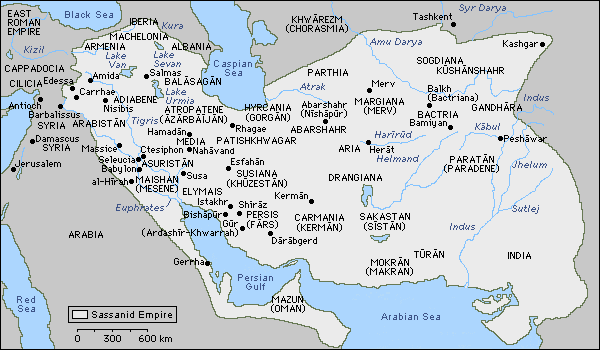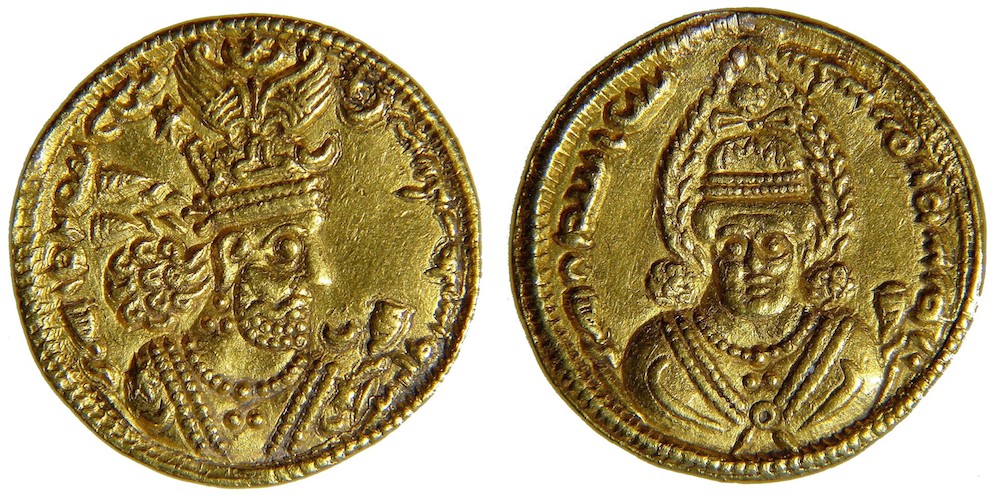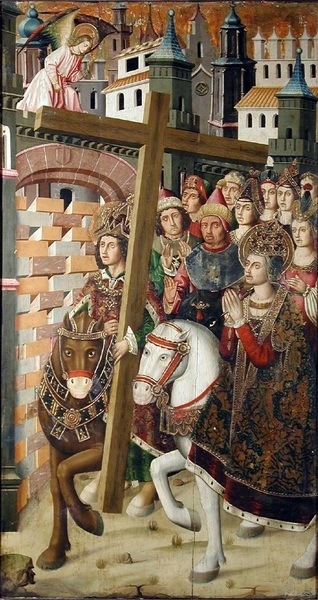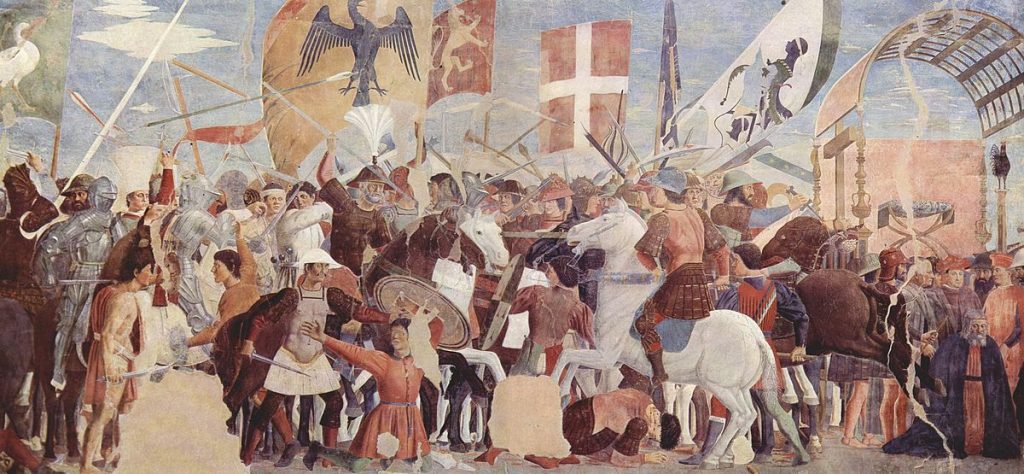Prophet Mohammad and Khosrow Parviz were born only months apart (570, 571 A.D) and both died within a few years of each other. Arab tradition has it that Mohammad in a letter to Khosrow asked for his submission but he tore the letter to pieces. As far as Khosrow Parviz was concerned there were only two empires and two religions. The Byzantine empire and his own Sassanid Empire. Christianity and Zoroastrianism. While Mohammad was working hard to bring unity to his people by uniting them under one religion and one government Khosrow Parviz was exhausting the resources of his empire by fighting the Byzantines and adding more concubines to his harem and entertaining the grand ambition of liquidating the Roman Empire in the east for good and becoming the king of kings (shahanshah) not just in title but in reality.
The Sassanids unwittingly facilitated the annihilation of their empire with series of terrible mistakes made by their last great king, Khosrow II, also known as Khosrow Parviz. The empire was vast, powerful with many high caliber army generals and military strategists. At the height of their power they had reached the same territorial boundaries of their ancestors, the Achaemenids. They were feared, respected and loved by their friends and foes.
Many have tried to understand the various battles between Persians and Arabs by looking at the military capabilities of the two and how their war strategy played against each other. But it seems that the clues as to why the Sassanids were overrun by the invaders to be found in the leadership of Khosrow II ( 590 first reign), (591 – 628 second reign).
Much has been written about his colourful life. Ferdowsi dedicates many verses describing how he came to power and how he ruled until he morally stooped in his conduct. His love affair with his Christian wife, Shirin, the first Christian queen of a Zoroastrian empire became an epic tragic romance story, Khosrow and Shirin by the poet Nezami (1141–1209). Khosrow’s name has been synonymous with music, arts and culture and opulence. But what his reign was really like and why as Firdowsi tells us he became unjust? But before looking at his life it would be useful to briefly look at the conflict between the Persian Sassanids and some of the Arab tribes.

It would be naive to believe that Arab invasion of Persia started with Umar the third Muslim Caliph. There was always tension between tribal Arabs and the Sassanids forces which sometimes resulted in warfare. The worst clashes took place during the reign of Shapur II ( reign 309-379).
After the Arabs attacked Persian territory Shapur responded swiftly, but also heavy handedly which earned him a title, Dhū l-Aktāf “he who pierces shoulders.
“Not only did Shapur II pacify the Arabs of the Persian Gulf, but he also pushed many Arab tribes further deep into the Arabian Peninsula. Furthermore, he also deported some Arab tribes by force; the Taghlib to Bahrain and al-Khatt; the Banu Abdul Qays and Banu Tamim to Hajar; the Banu Bakr to Kirman and the Banu Hanzalah to a place near Hormizd-Ardashir. (Wikipedia)
It would have been hard for the Arabs to easily forget how Shapur not only defeated them but uprooted them and resettled them in various geographical locations.
Prior to Umar’s invasion, Khosrow’s forces clashed with Banu Bakr bin Wa’il tribe in the Battle of Thi Qar, in 609 AD.It was a win for the Arabs and the news of the Arab victory spread throughout the Arabian Peninsula like wildfire. This small but important military setback should have set the alarm bells ringing for the Sassanids but they were heavily involved in fighting the Byzantine armies and thought of it as a small distraction.
Analysing the political decisions Khosrow made throughout his reign it is not hard to conclude that they proved to be fatal, not just for himself who was imprisoned and executed by one of his sons, Qubad, but for his grandson Yazdgird III who had to face the Islamic army. After three decades of war with the Byzantine Empire the young Yazdgird found himself at the head of an empire that was depleted, demoralised and divided. Most probably by the time Yazdgird was crowned people had enough from all the coups and regicide that was happening and couldn’t have even be bothered to keep up with the changes at the top, the Sassanids royals had become irrelevant, even pernicious to the wellbeing of the general population who couldn’t see an end to the havoc wreaked by the rival factions in their lands.
Richard Stoneman who wrote the biography of Xerxes (2015) argues that Xerxes for all that he’s been criticised for, left his empire in good shape. This is evident from the long reign of his son, Artaxerxes I (465–425 BC) during whose kingship the empire was stable and prosperous. The opposite can be said about Khosrow Parviz who left the empire in disarray, bankrupt and vulnerable to invasion.
Neither of his grand plans eventuated. What kept him in power for as long as it did was his entanglement with the Byzantine Empire, his savage grip on power and his grand yet unrealistic ambitions that made people think he was up to something big. Khosrow never ran out of ideas that fuelled his expansionist policy. His enthusiasm hardly abated. He also had no moral qualms in killing any one whom he considered a threat to him or his plans. His close allies must have been beguiled by Khosrow’s seductive personality thinking he was the incarnation of the great Persian kings for he had plans to change the course of history. But he failed miserably at the end and it was the course of his own history and his people that was changed instead.

Effective political leadership is about foresight and political manoeuvring that can bring prosperity instead of ruin. Unity instead of division. Peace instead of war. Khosrow Parviz failed in every area.
The first eleven years of his reign is relatively peaceful but he still had to put down various rebellions to cement his power. He was ruthless but also rewarded his faithful and successful generals, knowing without them he was a goner.
The reason the first eleven years of his reign was relatively peaceful and his military campaigns within his empire successful it was because he didn’t have to worry about fighting the Byzantines. It was Emperor Maurice, who brought Khosrow Parviz to power by providing him with military aid when he escaped and took refuge in his court after Bahram Chubine forced him to flee by staging a military coup and crowned himself as king. Basically his good reputation is built on his first 11 years as king, thanks to Maurice and Khosrow’s two uncles who engineered his comeback.
When Emperor Maurice was killed by Phocas, Khosrow renewed his war campaign to fight the Byzantines to reclaim all those territories and concessions that he made to Maurice for restoring him to the throne, and to crown his son, Theodosius as Emperor. This is a turning point in Khosrow’s reign. And Firdowsi, the great moral teacher alludes to his sudden shift of direction:
“Despite his splendid throne, the great palace he built in Ctesiphone, and all his imperial glory, the world’s king was dissatisfied, and he raised dust clouds of strife over Iran and Turan. This king who had been so just became unjust, and he rejoiced in the injustice of his inferiors.”
At first glance you would think Khosrow was being faithful to Maurice by returning the favour. He even held a crowning ceremony for Theodosius in Ctesiphon but the Romans dismissed Theodosius for not being Maurice’s real son. But the more inroads Khosrow makes into Byzantine Empire the more forgetful he becomes about his initial reason to start the campaign which was to crown Theodosius.
The Sassanids military conquests began to worry the Byzantines. And it did not slow down even after Phocas left the scene and Herakleios became the emperor. The Sassanids finally laid siege to the Byzantine capital, Constantinople. According to one account Herakleios wanted to abandon the city thinking it was all lost when Sergius I of Constantinople the Ecumenical Patriarch urged him to stay and have faith in victory. According to another account Herakleios was not even in the city and already fighting the Persians in the east but a general by the name of Bonos was in command. However, it was a terrifying experience for the civilians who walked ‘around the walls of the city, carting their icons of Christ and chanting the Akathistos hymn, which calls the Mother of God for divine assistance.’ Constantinople walls stood firm and some even saw the Mother of God herself leading the battle against the Persians and their allies.

It was the worst siege Constantinople ever had. The Persians who were the master of siege warfare couldn’t take the city. After this miraculous delivery Herakleios became determined to defeat the Sassanids empire and not fear them anymore. He couldn’t but not believe that God was on his side and victory his.
Prior to the Persian retreat Herakleios was willing to negotiate. Khosrow could have virtually written anything down and Herakleios would have signed it. They were happy for Theodosius to be crowned as emperor. Herakleios called himself the son of Khosrow in a letter to him and the avenger of Maurice by killing Phocas his murderer. It was no longer about justice or crowning Maurice’s son (if it ever was) but liquidating the Roman empire. Whether that was Khosrow motive from the beginning it’s hard to ascertain. But the taste of his earlier victories gave him very lofty ideas. As rewards he had already given parts of Byzantine territories to the Avars and the Slavs who were helping his forces to defeat the Byzantine army. This is how certain he was in his victory over the Byzantines.
***
What was Khosrow going to do with the Christians living in the Byzantine territories if he was going to become their king as a Zoroastrian? But Khosrow always had a plan, only if they ever worked. In an attack on Jerusalem in 614, with the help of the Jews they capture the city. It was reported that Persian soldiers damaged and desecrated the Church of the Holy Sepulchre and carry away the Holy Cross. Some historians start the unofficial date of the crusades with this blasphemous assault against Christians. However, this was not a random act of vandalism. And recent archeological assessment is not conclusive about any extensive damage to the site by the Persians. Nevertheless the act itself was bad enough and was used against Khosorw in a very effective propaganda campaign by Herakleios and his Patriarch Sergius I. Khosrow’s masterplan was to make the centre of Christianity in the Persian Empire after he vanquished the Byzantine Empire. He was on good terms with the Christians living in his territory. The Persian Church which is also referred to as Nestorian Church or the Church of the East was very much proactive and received allocated funding. Shirin, his Christian wife was influential in securing privileges and rights for the Christian minority. During his reign only a handful of converts to Christianity were martyred. His policy of religious tolerance never wavered despite Herakleios telling his Christian soldiers that dying in his war campaign against the Persians made them martyrs.
The True Cross entered Ctesiphon ceremoniously and later delivered to Shirin who kept it in her palace for safe keeping. Shirin was a great political and religious asset for the future of Khosrow’s unrivalled empire. If he succeeded she would be the queen of his Christian subjects while he remained the head of his Zoroastrian population and its institutions. However, Herakleios and Sergius I of Constantinople had read his hands. It was during the same period (610 and 622) that they began ‘to reassert the outcome of the Second Council of Constantinople which was held in 553 AD with its main purpose to make plain that the Great Church, which followed a Chalcedonian creed, was firmly opposed to Nestorianism,’ which every one knew was the Church of the Persian Empire even referred to as Persian Church. Herakleios was trying to stay ahead of the game by widening the already schism between his version of Christianity which was the dominate brand in his empire and the Persian brand.
Nestorianism, the indigenous Persian Church, however was no longer the only version of Christianity in Khosrow’s cosmopolitan empire. The number of Monophysites had also significantly increased in his realm and they were neither in harmony with the Nestorians or with the Roman Catholic, Maronite Eastern Orthodox. Khosrow knew that there was a good number of Monophysites also living in the Byzantine held territories as well, so he was determined to demonstrate a positive leadership among the Christian communities in his neck of the woods that harmonised the co-existence of all Christians sects. The grass indeed was greener in Khosrow’s empire for the Monophysites. And Khosrow’s tolerant religious policy did get the attention of monophysites but not enough to win them over or start a religious revolution against Herakleios. And the stealing of the Holy Cross in the meantime only damaged Khosrow’s reputation in a world where most people confessed a religious faith. And if Khosrow ever hoped that one day he would pull the Cross out of Shirin’s private chapel to be displayed in Ctisphone and make his capital the epicentre of Christian pilgrimage that propitious day never came. Herakleios only used it to his own advantage and turned it into a holy war. He also targeted Zoroastrian most sacred site, Azar Goshnasp.
Ten years after the Persian took the Holy Cross Herakleios desecrated and sacked Azar Goshnasp (آتشکده آذرگشنسپ). Once again Khosrow Parviz escaped as his newly built palace, Dastagird, was about to be captured and destroyed by Herakleios. But in his second and last escape he had nowhere and no one to run to and by then many had turned against him. Herakleios was given back the Holy Cross but the Sassanids realised this may not be enough to save them. So they had to do what pleased everyone, they imprisoned the king and replaced him with his son Qubad and sued for peace. For all his good intentions for the empire, Khosrow had made a terrible mess of everything and he had to be killed.

With his decisive win over the Sassanids, Herakleios put an end to the devastating wars that continued between the two empires for nearly 30 years. As they all returned home to count their losses and lick their wounds the Arabs who were watching them and hearing about their wars were about to enter the political stage, fresh and ready for the first time in their history to do battle.
Perhaps neither of Khosrow’s disastrous decisions was as detrimental in consequence than killing the Lakhmid king, Noʿmān. Hira his capital was the capital of the Lakhmid Arab tribe who was loyal to the Persians. They were mostly pagans and Nestorian Christians and their territory was a buffer zone that stopped the Arab tribes to attack the Sassanids territories. This was the same boundary that Shupur previously had marked and in order to prevent the Arabs coming further into his territory he ‘ordered the construction of a wall near al Hirah which became known as Wall of the Arabs’. Lakhmids had faithfully protected the boundaries entrusted to them against any incursions. There was a long and loyal history between the Sassanids and the Lakhmids kingdom. In the past they had brought up Bahram Gur and later helped him to the throne. They had fought with and for the Persian army in many battles . Why did Khosrow dismantle his own client state that strategically protected a very sensitive region? It’s hard to understand. And why did no one stop him? It is quite possible the Lakhmids who felt betrayed by Khosrow began negotiations with the Muslim Arabs. It was not possible for the Muslim army to attack the Sassanids without enough intelligence. With the loyal Lakhmids removed no one could oppose the Arab advances any more. For the first time they could march unopposed ever closer to the Persian heartland. According to Tabari the Muslim community which was a highly militarised community operating out of Medina was well informed of what was going on between the Persians and the Arabs. After the Arabs defeated the Sassanian army at Dhu-Qar in 609, Muhammad rejoiced in that victory and said, “This is the first battle in which the Arabs took equitable vengeance on the Persians, and they achieved this victory through me.”
Khosrow’s failed ambitions paved the way for the near destruction of Persian culture. He was also responsible for the loss of Byzantine territories to the Muslim army, for the Byzantines Empire too had run out of puff after being forced to defend their empire against Khosrow’s prolonged military campaigns. If Khosrow knew his limits and had agreed to negotiate when Herakleios almost grovelled at his feet it would have been a great victory for Khosrow.
It is hard to imagine someone like Khosrow who loved music so much how impervious to people’s misfortune he was. He gave with one hand and took with the other. Spent lavishly on his pleasures. He never hesitated to issue a death warrant for anyone whom he suspected of treason and finally caused the mutiny of his best field generals. He killed both his uncles who advised and helped him to reclaim his throne from Bahram Chobine. Even in Nizami’s story of Khosrow & Shirin, Khosrow’s malign personality cannot be glossed over: “Ḵosrow, unable to dissuade Farhād from abandoning his love for Šīrīn, charges him with the task of cutting a road through the rocks of Bīsotūn, agreeing to give up, as a reward, his own claim to Šīrīn. Farhād takes up the challenge; when Ḵosrow learns that this seemingly impossible labor is almost done, he sends Farhād the false news of Šīrīn’s death. In his despair, Farhād falls from the rocks and dies.”
But Khosrow’s end was more tragic that could fit in any work of literature by Nizami, Firdowsi or Goethe. Khosrow during his reign caused an immeasurable amount of pain and grief for many people, most of whom close to him. Finally his misdeeds caught up with him but alas it was too late and more innocent people had to die. His son Qubad as soon as he became king ordered the killings of all his brothers and half brothers, about 18 siblings. He had Mardanshah, Khosrow’s favourite son and his future heir to be killed in front of his father!
There was hardly any letup in bloodshed as civil war engulfed the empire and suddenly but not unexpectedly the crushing wars with the Arabs broke out.
It is a great injustice to equate Yazdgird with the loss of the Sassanids Empire for he only tried to save what was already lost by his grandfather’s disastrous management. But the greater tragedy is to think of Khosrow Parviz as a great king.
References:
1.Iranica
2.Wikipedia
- Decline and Fall of the Sasanian Empire: The Sasanian-Parthian Confederacy and the Arab Conquest of Iran, by Parvaneh Pourshariati.
- Sasanian Persia: The Rise and Fall of an Empire by Touraj Daryaee.
- The Shahnameh: The Persian Book of Kings, a new translation by Dick Davies.
- Byzantium: The Surprising Life of a Medieval Empire, by Judith Herring, Penguin Books, London, 2007.






